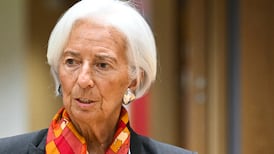Irish consumers must have been scratching their heads last week as two high-profile forecasts, from the Minister for Finance and employers’ group Ibec, suggesting inflation would come down faster than expected, and could be as low as 4 per cent by the end of the year, seemed to flounder in the face of the actual data, which showed price growth had accelerated again in February.
The latest harmonised index of consumer prices (HICP) compiled by the Central Statistics Office (CSO) showed inflation in the Irish economy unexpectedly rose to 8 per cent in February, up from 7.5 per cent the previous month.
Economists and policymakers had been expecting another drop in the headline rate on the back of falling energy prices and in the wake of three consecutive monthly declines. Inflation peaked in Ireland at 9.4 per cent in October before falling back in November, December and January. The surprise increase in February was driven by higher food and transport prices, which outweighed the decline in energy prices.
[ Irish inflation unexpectedly rises to 8% in FebruaryOpens in new window ]
At no time in the past four years has there been more confusion, more mixed signals about the future direction of the global economy. Central banks have lifted interest rates at a pace that economists thought would prove crushing for growth and employment.
READ MORE
Inflation has slowed fractionally but not enough, and the cautious note being sounded by central bankers reflects that. Bundesbank president Joachim Nagel said last week that the recent fall in energy prices had failed to improve medium-term prospects, so that the ECB may need to opt for another large rate hike in May.
And while higher interest rates have dented demand in certain sectors, consumers, against expectations, keep finding the money to spend. The volume (not the price) of retail sales here rose by 3 per cent year-on-year in January despite a severe cost-of-living crisis.
One of the elements that drove inflation here higher was the cost of transport, including air fares, which typically reflect greater consumer demand. Year-on-year comparisons are perhaps a little warped by Covid but the ongoing growth in services spending is almost certainly being facilitated by growing employment and earnings.
Stronger-than-expected consumption means that the recessions forecast for Europe and the US have – so far – failed to materialise. ECB officials are now said to be more concerned that the high levels of employment and soaring job vacancies may thwart a modest rise in unemployment that many feel is needed for inflation to fall.
The confusing array of data has markets (they’ve risen strongly since the start of year) pivoted one way and policymakers the other. Responding to the latest dip, Matt Raskin, head of US rates research at Deutsche Bank, said: “The market had got way in advance of itself with the ‘inflation is dead’ narrative.”
The latest Irish price data fed into the euro zone inflation numbers, published on Thursday, which pointed to a headline rate for the currency bloc of 8.5 per cent in February, down fractionally from January’s 8.6 per cent but above earlier expectations of a more significant decline. Economists polled by Reuters had expected 8.2 per cent
More worryingly, core inflation, which strips out energy and food prices (an indicator watched closely by the ECB), rose from 5.3 per cent to 5.6 per cent, a record for the euro zone, and a reading that will underpin expectations of higher interest rates. The ECB is expected to opt for another half point bump in rates this month, bringing its main refinancing rate, the one that affects mortgages, to 3.5 per cent, up from zero per cent last July.
We’ve tended to view the spike in inflation as a consequence of higher energy prices. Now that they’re going down so should inflation, shouldn’t it? Well, it’s not that simple.
Retail energy prices tend to lag wholesale prices as energy suppliers buy in advance (a process known as hedging) similar to the way airlines hedge future fuel consumption to avoid spikes in oil prices.
And then there are what economists call second-round effects when higher energy prices spill out into the wider economy. Part of this is unavoidable as businesses use energy too and higher prices, particularly in the area of food, reflect that.
The main thing keeping ECB policymakers up at night is wages. Workers typically demand better compensation when the cost of living goes up.
Wages in Europe and the US are rising quite strongly in certain sectors. They rose by 4 per cent here last year but the average hides big sectoral disparities. The unexpected dimension is the strength of the jobs market, including the high rate of job vacancies, which is further fuelling wage pressure.
Central banks are not facing the kind of wage-price spiral that engulfed economies in 1970s. Back then employees won big, inflation-busting pay hikes that embedded inflation in the economy.
“Even after energy and pandemic factors fade...wage inflation will be a primary driver of price inflation over the next several years,” ECB chief economist Philip Lane warned recently. Even modest pay increases have the potential to keep inflation elevated. But telling workers to suck up the erosion in real wages is not something you want to be doing as a politician.
Much will depend on whether job markets slow and take the pressure off wages. Ironically, policymakers would welcome a bit of unemployment.















